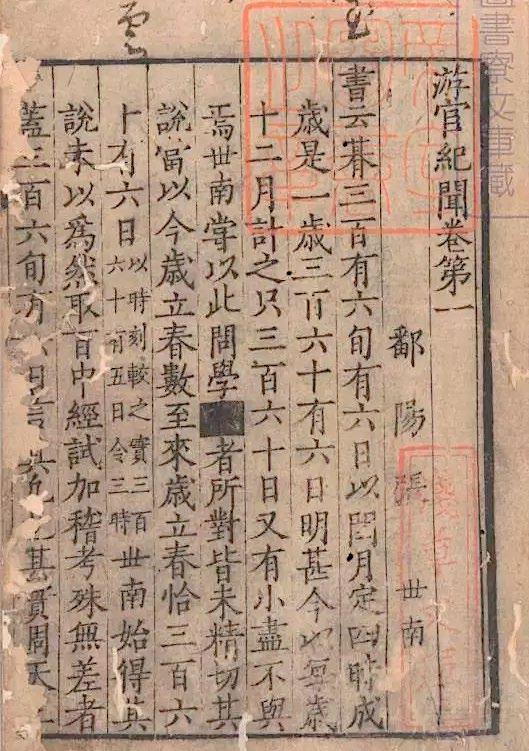NOVEMBER a RTWORK s
pieces are published and changed each month. The objects are presented with a full description and corresponding dealer’s contact information. Unlike auction sites or other platforms, we empower collectors to interact directly with the member dealers for enquiries and purchases by clicking on the e-mail adress.
In order to guarantee the quality of pieces available in the catalogues, objects are systematically validated by all our select members, who are the in-house experts.. Collectors are therefore encouraged to decide and buy with complete confidence. In addition to this, the Asian Art Society proposes a seven-day full money back return policy should the buyer not feel totally satisfied with a purchase.
Items are presented by categories, please check the table of contents. Feel free to ask the price if the artwork is listed with a price on request.
november 2022 - 7
S ale

8 - ASIAN ART SOCIETY
Budd H a Bi RTH R E li E f
Ancient Gandhāra region
2nd-3rd century
Schist
Height: 45 cm
provenance:
Franco Giubergia, Turin, 1999
French private collection (by repute)
price: 18.000 euros
An essential scene in the life of Buddha Śākyamuni: his birth
It was in the Gandhāra that the iconography of the Buddha in human form was gradually established. The Gandhāra school emphasizes the last existence of the historical Buddha, as well as his previous lives or jātaka. It developed a syncretic style, which can be seen here in the use of carefully sculpted drapery reminiscent of classical Hellenistic statuary. The scene depicted is easily identifiable: it is the birth of Buddha Śākyamuni, the historical Buddha. In keeping with classical iconography, it depicts Queen Māyā -the Buddha’s mother -in Lumbinī, grasping a branch of the śāl tree with her right hand. From her side is born the future Buddha, gathered in a cloth stretched by Indra. On the right, Mahāprajāpatī supports her sister, and gently touches her belly, as if to soothe her.
a characteristic syncretic art
The Hellenistic influence is remarkable here, particularly in the drapery and the modelling of the bodies. The features of the figures are finely incised, the attitudes graceful and dynamic. The hairstyles are worked into characteristically soft curls; the care taken with Indra’s hair, as well as the various ornaments of Māyā and her sister, is noteworthy. The śāl tree, the sacred tree, unfolds above the figures in delicately carved scrolls. Indian iconographic influences meet Greek stylization here, providing a syncretic whole characteristic of the Gandhāra region, all set in a lively and detailed ensemble.
The art of narrative in Gandhāra
Obje C
Christophe
Hioco
T: +33 (0) 1 53 30 09 65
E: info@galeriehioco.com
W: www.galeriehioco.com
It can be assumed that this relief was originally part of a frieze dedicated to the life of Buddha. It was usual to find such scenes in the monasteries of Gandhāra. The latter were composed of two types of spaces: courtyards accessible to devotees and cluttered with all sorts of exvoto monuments, such as burial mounds (stūpa) and chapels, and beyond that an enclosure reserved for monks only. In the public areas, the bases of the stūpa, the door and window surrounds, the plinths and sometimes even the risers of the stairs bore numerous reliefs, juxtaposing decorative motifs and apologetic narrative scenes, of which this relief can be assumed to be a part.
november 2022 - 9 01
t P R e S e N ted by:
H E ad O f B O d H isaTTVa
Gandhara
Circa 3rd-5th century
Stucco with traces of polychrome
Some restoration on the noose and chin
Height: 25 cm
provenance:
Tony Anninos, USA
price: 12.000 euros
This head of Bodhisattva is modeled in stucco, a mixture of gypsum, sand, lime and water. His eyes with pronounced lids are open. The arches of the eyebrows dissolve smoothly into the aquiline nose. The sensuous lips are full and pronounced. The lips are crowned by a long wavy moustache with curled tips. The rows of waves of the hair are held together with a diadem, bejeweled with beads and small heads of Makaras at each side with their mouth exposed. The long earlobes are decorated with refined ear ornaments. Traces of pigment are still visible on the diadem, the hair, the eyes, the lips, the moustache and the ears.
During this period Bodhisattvas were represented as princes with the attire of a Central-Asian nobleman.
Many traits of the classical naturalistic Greek culture were melted with the Central Asian Kushan and also the Northern Indian Gupta/Mathura aesthetic ideas from the start of the 1st century A.D.
Obje C t P R e S e N ted by:
Farah Massart
M:+32 495 289 100
E: art@famarte.be
W: www.famarte.com
10 - ASIAN ART SOCIETY 02

november 2022 - 11

12 - ASIAN ART SOCIETY
november 2022 - 13
a CRys Tal a N d GO ld s T u Pa
Gandhara
1st BCE to 7 CE
Height: 8,5 cm
price: 20.000 USDt
A rare crystal reliquary in the form of a Stupa in three parts, consisting of a round hollow drum base with moldings to form a plinth around the bottom and a cornice on the upper edge, both receding into a plain central band. The crystal covered by a granulated gold mesh inset with gemstones.
Obje C t P R e S e N ted by:
Sue Ollemans
M: + 44 (0) 7775 566 356
E: sue@ollemans.com
W: www.ollemans.com
14 - ASIAN ART SOCIETY 03

november 2022 - 15
T il E
Damascus, Syria
Ottoman Empire
17th century
Fritware with underglaze painted decoration
21,3 cm x 25,5 cm
price: 2.500 euros
Obje C t P R e S e N ted by:
Alexis Renard
T: + 33 1 44 07 33 02
E: alexis@alexisrenard.com
W: www.alexisrenard.com
16 - ASIAN ART SOCIETY 04

november 2022 - 17
Ra KTa KRudd H a
Va R a H i
Mongolia
19th century Mineral pigment and gold on paper
11 cm x 9 cm
provenance:
Acquired from Suzy Lebasi 4 November 2002
Boris Kaspiev collection price on request
Obje C t P R e S e N ted by: Hollywood Galleries
T: +852 2559 8688 / +852 2541 6338
E: hollywoodgalleries@gmail.com
W: www.hollywood-galleries.com
Encircled by flames, the red Raktakruddha Varahi, the consort of Chakrasamvara, dances in ardhaparyanka asana on a corpse, which lies on a sun disc and lotus within a crossed triangular mount, symbolising method and wisdom. She brandishes a kharttika (chopper) in her outstretched right hand, and in her left hand she holds a blood-filled skull cup. In the crook of her left hand is a khatvanga, or staff. Her naked body is adorned with a crown of five dry skulls, bone ornaments and a garland of freshly severed heads. In her flaming red hair is a sow’s head, which gazes up to the paradise realm of dakinis. Seated above her in the clouds is the four-armed Prajnaparamita. Raktakruddha Varahi is surrounded by the four directional dakinis. Clockwise from top left – Padma Dakini; Karma Dakini; Vajra Dakini and Ratna Dakini.
The visualisation of Raktahruddha Varahi is employed in the chod practice for cutting through strong attachments.
On the reverse, there are six sets of the blessing and empowerment mantra ‘Om Ah Hum’ for each of the six figures on the front side.
Refer Mongolian Buddhist Art, Volume 1 part 2 Thangkas, Appliques and Embroideries, Serindia, USA, 2011, plate 309 page 700 for similar.
18 - ASIAN ART SOCIETY 05

november 2022 - 19

20 - ASIAN ART SOCIETY
november 2022 - 21

s addl E Ru G
Tibet
Late 19th century Knotting. Wool pile, cotton warp, and dyes
Height: varying from 49 cm to 54,6 cm
Width: 118 cm
provenance:
European collection price: 2.500 USD
Obje C t P R e S e N ted by:
Alan Kennedy
M: +1 646 753-4938
E: kennedyalan@hotmail.com
W: www.alankennedyasianart.com
Motifs: border – endless knot variant and interlocking diamonds field – stylized flower and vine medallions; large open medallion at the center with floral buds; four white squares filling in the places where straps would be passed through to secure the saddle rug to the horse.
The quality of the wool and the dyes is high, the wool being soft and lustrous. Such a saddle rug would have been placed over a wooden saddle in order to provide the rider with a more comfortable ride, with the added protection of the auspicious motifs that decorate the rug.
november 2022 - 23 06
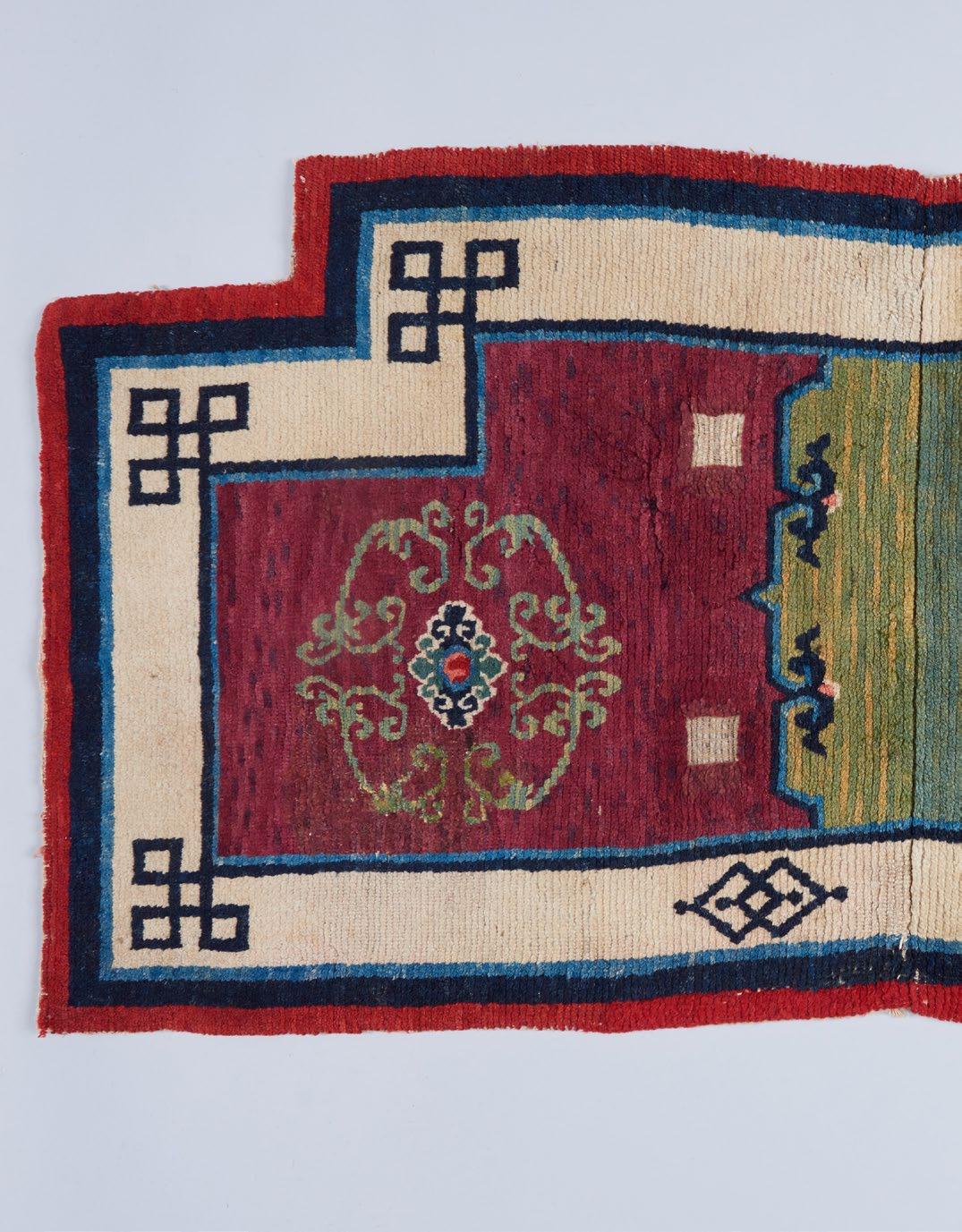
24 - ASIAN ART SOCIETY

november 2022 - 25
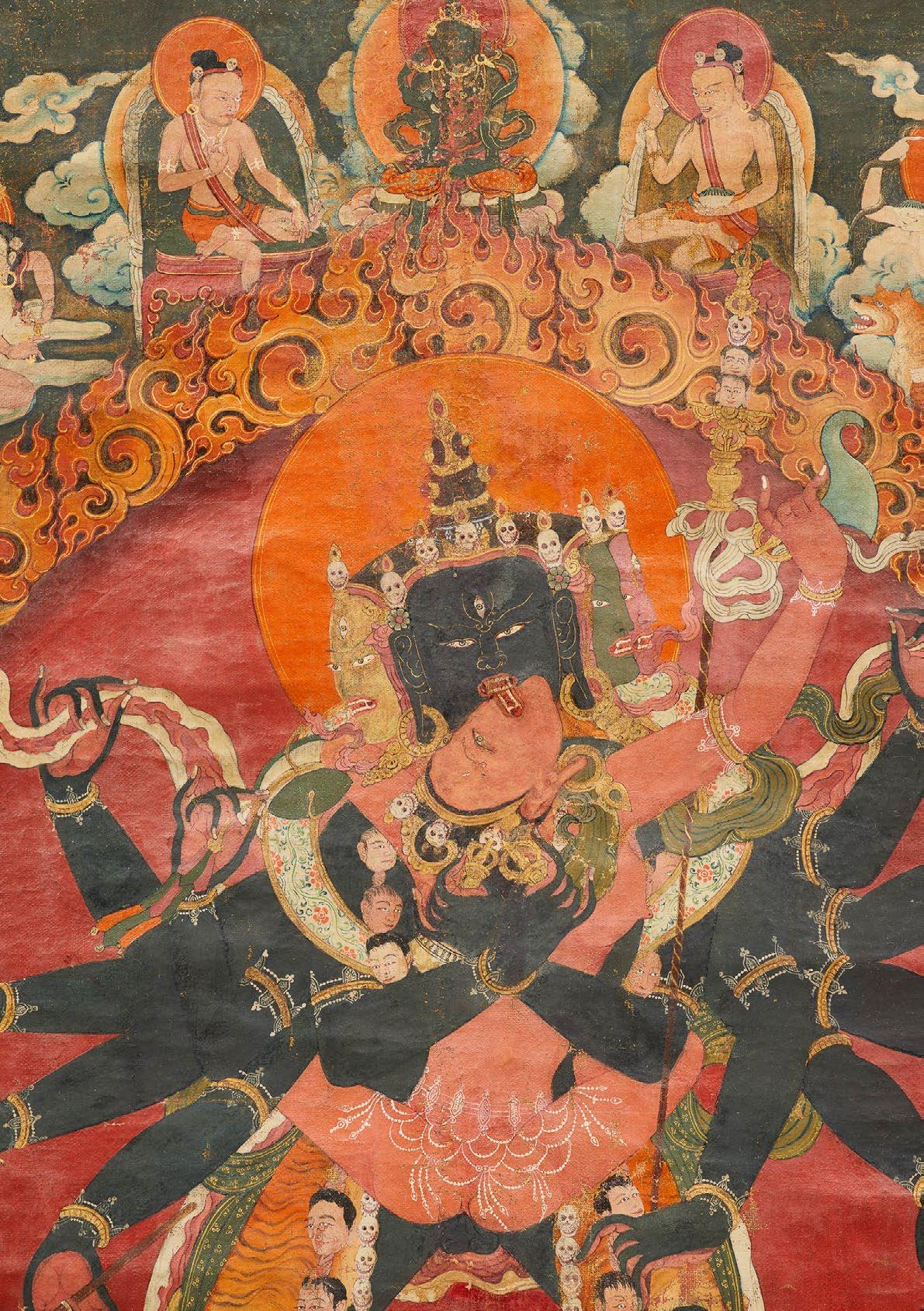
C H a KR asa MVa R a a N d CON s ORT
Tibet 17th century Mineral pigments with gold on cloth
86 cm x 64 cm
provenance:
From the Uzes Collection (France), acquired in the 1950s. price on request
Chakrasamvara, which translates as wheel of bliss, is one of the most popular yidam, or meditational deities, in Tantric Buddhism after the 11th century. As the principal deities of the Anuttarayoga Tantra of the Vajrayana Buddhist Tradition, Chakrasamvara can appear in several dozen different forms, from simple to complex, peaceful to wrathful. Here Chakrasamvara and his consort Vajravarahi are both with a wrathful appearance, standing on Red Kalaratri and Black Bhairava, symbolizing the triumph over ego and ignorance.
Chakrasamvara, who is blue in color, has four heads and 12 hands, in which he holds an elephant skin behind his back, a staff, a skullcup, a golden lasso, Brahma’s four heads, a trident, a flaying knife, an ax, a drum, a vajra and a bell at center. Both Chakrasamvara and his consort Vajravarahi wear a skull crown, a garland of freshly severed heads, and are surrounded by the blazing flames of pristine awareness.
A register of deities is at the top of the image. From left to right they are identified as Vajrayogini, Vajrasattva, Ghantapa, Tipola, Vajradhara, Naropa, Dombi Heruka, Akshobhya, and Hayagriva. An attendant figure is positioned on the left of Chakrasamvara and Vajravarahi. He is mostly likely to be Kankalipa, one of the 84 mahasiddhas who meditated many years upon his deceased wife as a Dakini, the emptiness, and attained the state of mahamudra-siddhi.
M:
E:
W: www.kapoors.com
november 2022 - 27 07
Obje C t P R e S e N ted by: Kapoor Galleries
+ 1 (212) 794-2300
info@kapoors.com
28 - ASIAN ART SOCIETY

november 2022 - 29

Tibet
Obje
M:
In Sanskrit “Vajra” translates literally to both thunderbolt and diamond. These two seemingly different subjects are linked together in one word for their properties; the irresistible force of a thunderbolt and the indestructibility of diamond, two awesome forces of nature. “Pani” literally translates to “in hand.” Vajrapani is one of the oldest Dharmapalas within Mahayana Buddhism, and amongst three main protective deities of the Buddha. He is said to be the embodiment of all of the Buddha’s power; and the physical representation of the energy within an enlightened mind, a “knife of energy” to cut through the fog and delusion of unclear thinking. Amongst Vajrapani’s roles is the duty to watch over all of the Tantra literature, giving him another name,“Guhyappati” or “Lord of secrets.”
The origins of Vajrapani stem from “Pali Canons Ambatha Suttanta’’, a tale which directly puts a challenge to the caste system. Vajrapani is first seen as a yaksha (nature spirit). The Ambattha Suttanta is the first time Vajrapani is encountered, and he is portrayed as a threatening demonstration of the Buddha’s power. At the request of his mentor, a young Brahmin by the name of Ambatha visited the Buddha. Ambatha was already well aware of the Buddha’s lineage before his encounter with him, and that he and his family were members of the Shakya clan, who were of the Kshatriya caste. Throughout their encounter Ambatha failed to show Buddha the respect he would have for a fellow Brahmin. When the Buddha queried as to why Ambatha was showing him this lack of respect, he replied it was because the Buddha belonged to a “menial” caste. The Buddha, being all knowing and enlightened, then asked the Brahmin if his family was descended from a “Shakya slave girl”. Knowing that this was the truth, Ambatha refused to answer the question. After Buddha asked the question one more time he warned Ambatha that his head would be smashed to bits if he failed to answer a third time. In response to the Buddha’s threat, Vajrapani manifested above Buddha’s head, ready to strike Ambatha down with his Vajra (thunderbolt). Upon seeing this Ambatha quickly admitted that what the Buddha spoke was the truth.
november 2022 - 31 08
Vaj R a Pa N i
17th century Gilt Bronze with polychrome
on
Height: 16,5 cm price
request
C t P R e S e N ted by:
Galleries
Kapoor
+ 1 (212) 794-2300
info@kapoors.com
www.kapoors.com
E:
W:
The anthropologic origins of Vajrapani can be observed in several instances, two mainly. Mythical roots can be seen stemming to Indra, the thunder god of India, which inherently has deep connections to Zeus, the Greek god of lightning. The depictions of Vajrapani range throughout time, early images of the deity portray him in a much less “wrathful” form, and generally portray him as a powerful and muscle clad male, protecting the Buddha. All three gods can be seen wielding lighting, (Zeus literally, Indra and Vajrapani in the form of a Vajra) and Zeus and Indra both share positions in their respective followings as “King of the Gods”. Besides these more obvious parallels, “Dyaus” is Sanskrit for “sky” and Indra is also known as Indra Dyaus”. “Zeus” is the Greek form of Dyaus. Jupiter is “Dyaus-piter” or “sky father”.
Vajrapani, the bearer of the thunderbolt, in wrathful form represented in a powerful cast stands in alidasana, the warriors pose, wearing a dhoti incised with tigerskin stripes flanked by a windswept sash and jewelry adorned around his bountiful midsection, centered with beaded festoons. A thick snake is wrapped around the neck, The wild mane of hair is surmounting Vajrapani’s iconographic third eye. Detailed casting throughout, the face bears a fierce and detailed expression.

32 - ASIAN ART SOCIETY


november 2022 - 33
Ma N us CR i PT
Tibet
15th -16th century
37,5 cm x 11 cm
Mineral pigment and gold on paper provenance:
Acquired from Suzy Lebasi on 9 August 2003.
Boris Kaspiev collection price on request
Obje
Hollywood Galleries
by:
T: +852 2559 8688 / +852 2541 6338
E: hollywoodgalleries@gmail.com
W: www.hollywood-galleries.com
This is a page from a text enumerating the many names of the Buddha. It belongs to a group of works which, at root, aspire to hasten the coming of the next Buddha Maitreya, by intoning the names of the Buddhas of the past and present.
The title when translated from the Tibetan on the reverse side says that the name of the work is ‘The 5,453 names of the Buddha.’ This is written in Sanskrit transliteration in Tibetan script on the first page of the text.
The reverse side goes on to say: ‘Homage to the Omniscient Ones. The Arhat (Saintly One), the Tathagata (the Buddha Who has gone beyond suffering) who is absolutely stainless….’
34 - ASIAN ART SOCIETY 09
Pa GE W i TH TWO illu M i NaT i ON s
d EP i CT i NG THE Budd H a
e S e
C t P R
N ted

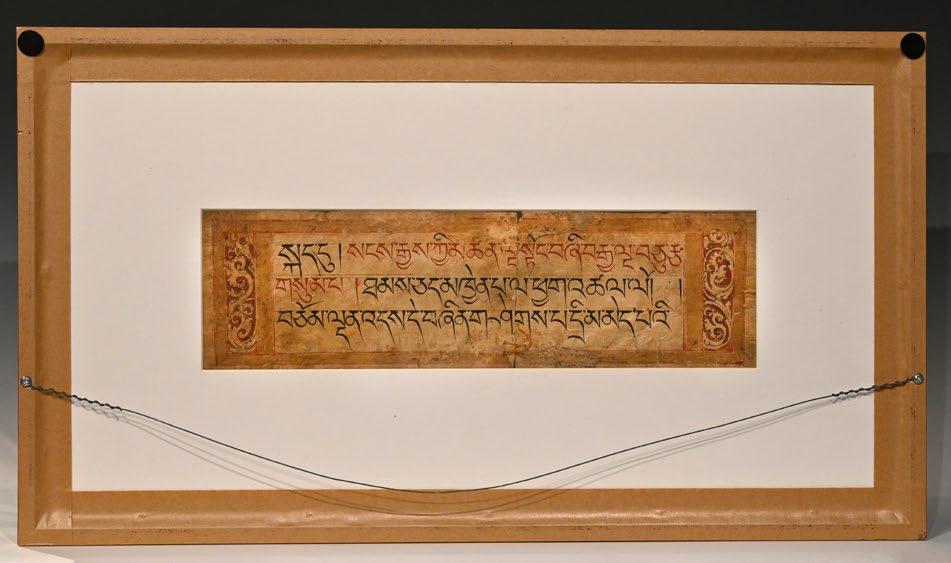
november 2022 - 35
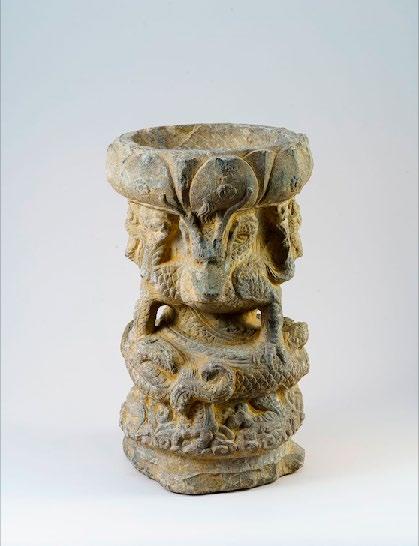
36 - ASIAN ART SOCIETY
a Ca RVE d sTONE
l a MP
Tang Dynasty China
7th century
Height: 29 cm
price: SOLD
Obje C t P R e S e N ted by:
Sue Ollemans
M: + 44 (0) 7775 566 356
E: sue@ollemans.com
W: www.ollemans.com
november 2022 - 37 10
W R i T i NG s l OPE
Canton, China
Early 19th century
Amboyna wood, dark overall patina
47 cm x 27 cm x 9 cm
price: 3.500 GBp
Obje C t P R e S e N ted by:
Brandt Asian Art
M: +44 (0)7774 989 661
E: brandt@nildram.co.uk
W: www.brandtasianart.com
An early 19th century campaign brass bound writing slope, constructed in solid burr amboyna wood. The opening slope with original Chinese baize and three hidden trick draws with a rich dark overall patina. The piece was presented to Henry Charles Caldwell of Singapore, living in Caldwell House 1836 and moved to Queens Road Hong Kong in 1863, where he became a partner in the Law Firm Caldwell & Brereton.
38 - ASIAN ART SOCIETY
11

november 2022 - 39

40 - ASIAN ART SOCIETY

november 2022 - 41
Zi Ta N B Ox E s
China
18th/19th century
10 cm x 7,5 cm
price: 5.800 GBp
Obje C t P R e S e N ted by:
Brandt Asian Art
M: +44 (0)7774 989 661
E: brandt@nildram.co.uk
W: www.brandtasianart.com
A pair of Zitan rounded rectangular boxes and covers, the central shaped panels carved with flowering prunus branches within raised rims. On four knob feet, the interiors with yellow silk linings.
42 - ASIAN ART SOCIETY 12

november 2022 - 43
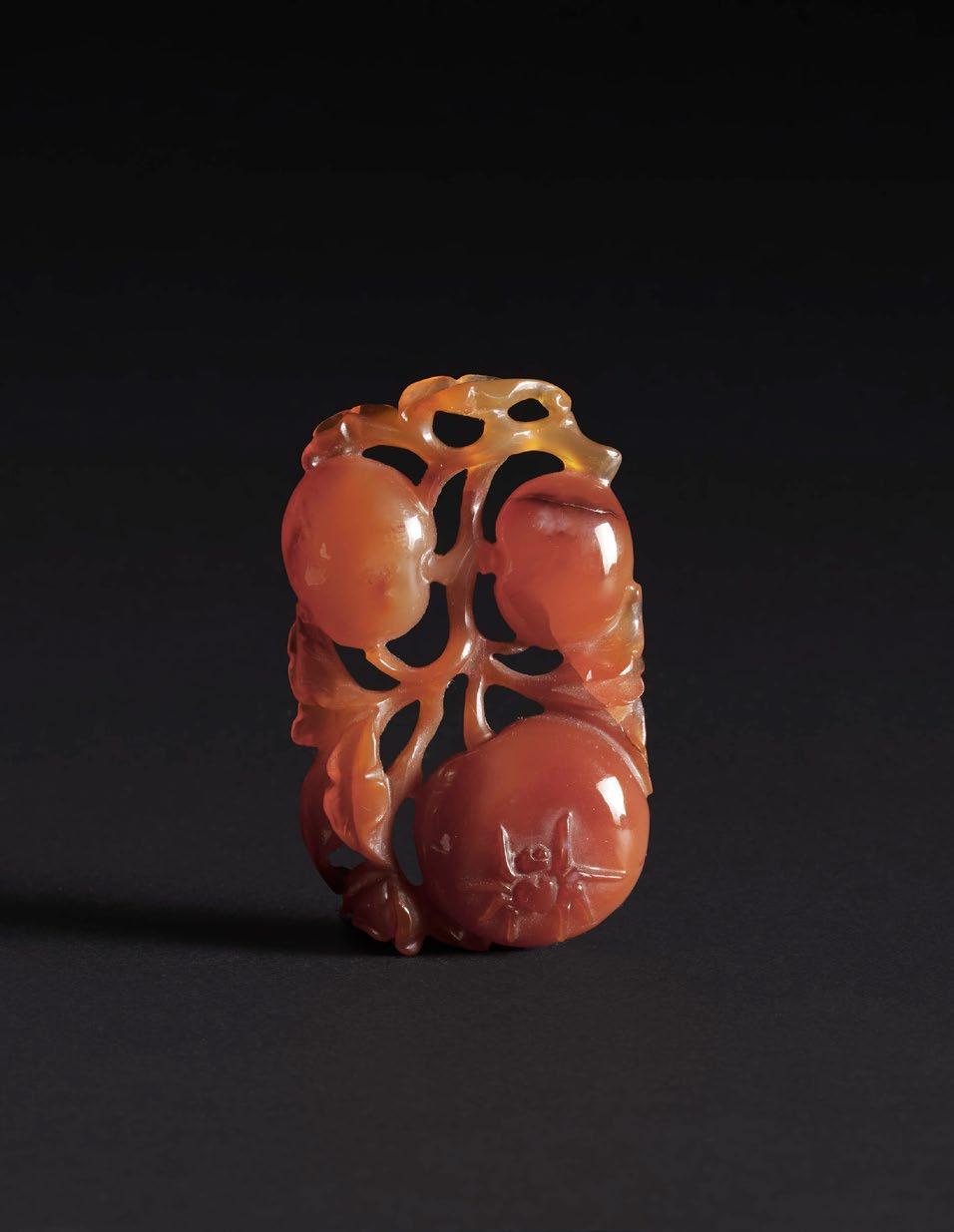
44 - ASIAN ART SOCIETY
A carnelian agate pendant, carved with a spider crawling on a fruiting branch.
Ca RNE lia N a GaTE PEN da NT
China
Circa 1900
Height: 6 cm
provenance: philip Cardeiro price: 680 GBp
Obje C t P R e S e N ted by:
Brandt Asian Art
M: +44 (0)7774 989 661
E: brandt@nildram.co.uk
W: www.brandtasianart.com
november 2022 - 45 13

46 - ASIAN ART SOCIETY
A miniature turquoise bead in the form of a recumbent ram; a turquoise bead in the form of a hawk; and two turquoise beads in the form of recumbent animals.
Tu R qu O is E BE ads
China
Eastern Han dynasty (25-220 CE)
Length: 1,3 cm-1,6 cm
price: 7.000 USD
Obje C t P R e S e N ted by:
Rasti Fine Art Ltd.
M:+852 2415 1888
E: gallery@rastifineart.com
W: www.rastifineart.com
november 2022 - 47 14

48 - ASIAN ART SOCIETY
COal BE ads
China
Eastern Han dynasty (25-220 CE)
Height: 1,6 cm-2,5 cm
price: 2.400 USD
Obje C t P R e S e N ted by:
Rasti Fine Art Ltd.
M:+852 2415 1888
E: gallery@rastifineart.com
W: www.rastifineart.com
Two miniature coal beads modelled as recumbent rams; another of recumbent animal with bulging eyes; and a coal miniature bead in the form of a tripod incense burner and cover.
november 2022 - 49 15

50 - ASIAN ART SOCIETY
a GaTE s CHO la R’s
WE i GHT
China
Fitted wood stand
Width: 8,5 cm
price: 1.700 USD
Obje C t P R e S e N ted by:
Rasti Fine Art Ltd.
M:+852 2415 1888
E: gallery@rastifineart.com
W: www.rastifineart.com
A black and deep-brown agate scholar’s weight resembling an abstract octopus
november 2022 - 51 16
s N uff BOTT l E
China Glass
1750-1795
Height: 2 3/8 in (6 cm)
(excluding the stopper)
provenance: A private Californian Collection
price: 5.500 USD
Obje C t P R e S e N ted by:
Clare Chu Asian Art LLC
M:+ 1.310.980.4084
E: clarechuasianart@gmail.com
A glass snuff bottle, of rounded form, with swirling colors of red, orange, yellow and green forming abstract designs, in imitation of realgar.
The colors of realgar glass are richly varied reflecting not only the attraction of the original material that the glass copied, but also the inherent magical qualities that made the stone a favorite of the Daoists. Realgar glass survives in tones of vivid dappled red to almost a monotone orange. It was not only glass snuff bottles that were made in imitation of realgar, but also vases, dishes and other scholars’ works of art. An example from the 1995 exhibition at the San Francisco Asian Art Museum, ’A Chorus of Colors,’ is a fluted glass vase imitating realgar with a base mark Qianlong nian zhi, helping to date the whole group of works of art including snuff bottles.
52 - ASIAN ART SOCIETY 17

november 2022 - 53
s N uff BOTT l E
China Glass 1820-1880
Height: 2 3/8 in (6 cm)
(excluding the stopper)
provenance: A private French Collection price: 5.500 USD
A glass snuff bottle, of slender rectangular form, carved using the ochre-yellow overlay over a green ground with on one side Mi Fu holding up a stick before a massive rock with a bat swooping above, an inscription to one side, the reverse with a goat-herder with a pair of goats, a pair of birds swooping above, with a seal to the lower corner. Yangzhou School.
The largest group of Yangzhou School overlay bottles, numerically, can be identified by its thin layer of single or multi-colored glass carved over a milk- white ground. Approximately one-third of these bottles have an inscription or seal such as "a gathering of heroes" or the name of a pavilion such as "Chiyuting" - the breath of rain pavilion - or simply a reference to the bottle itself such as "eight swift steeds" (a reference to the eight horses of Mu Wang). In addition, just over 10% of these bottles bear a cyclical date; sometimes alone, sometimes accompanying an artist’s seal or inscription.
The quality of this whole group is tremendously variable, from the poorest and meanest carving to the most elevated standard of decoration. As part of a commercial enterprise this is understandable and today bottles must be judged as any work of art with a combination of its technical finesse and artistic endeavor. This high quality, well-carved example is unusual in its color combination, and the additions of both a seal and an inscription relating to the bottle itself.
Obje C t P R e S e N ted by:
Clare Chu Asian Art LLC
M:+ 1.310.980.4084
E: clarechuasianart@gmail.com
54 - ASIAN ART SOCIETY 18
SOLD

november 2022 - 55
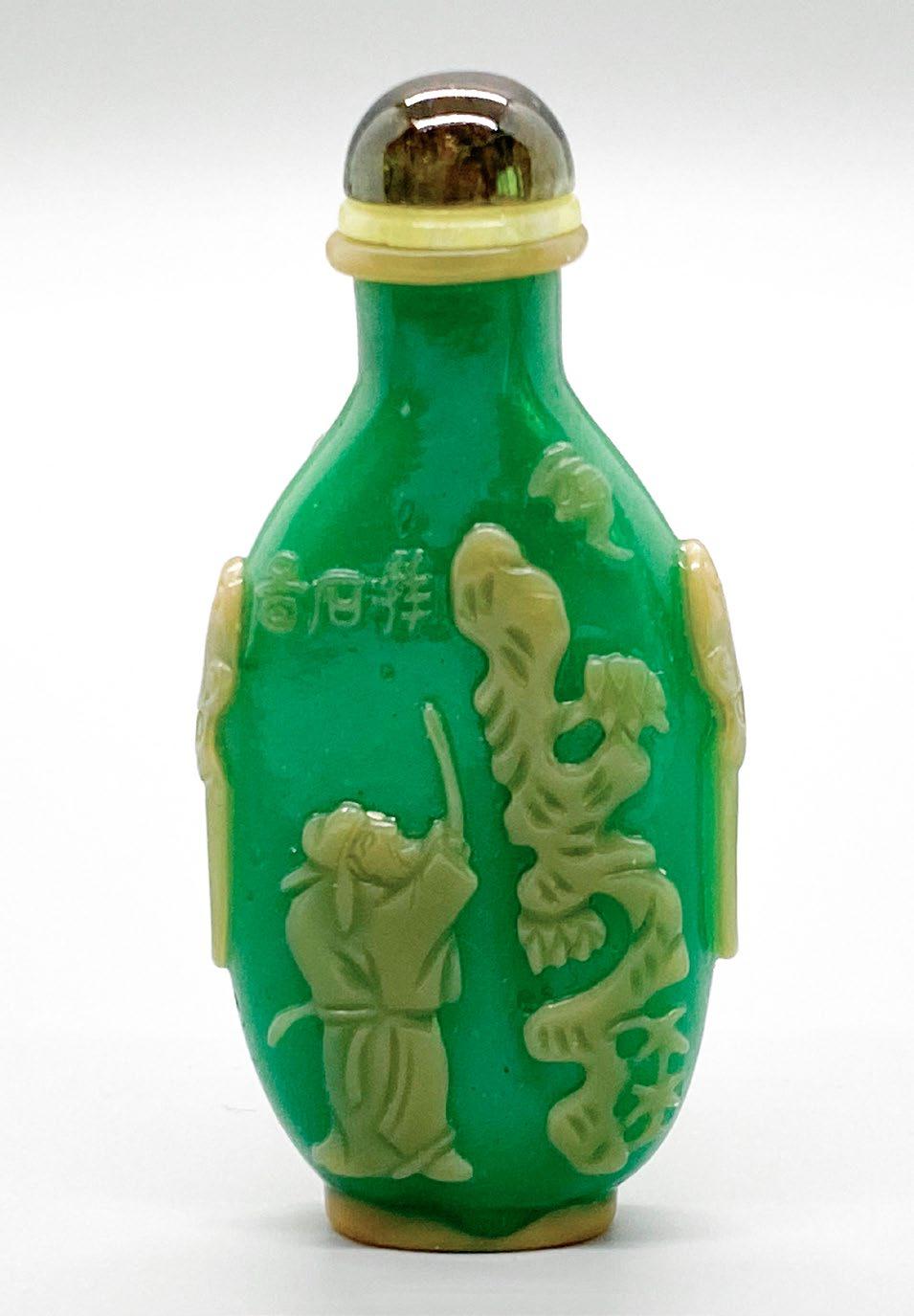
56 - ASIAN ART SOCIETY
november 2022 - 57

58 - ASIAN ART SOCIETY
s N uff BOTT l E
China
Cloisonné 1750-1795
Height: 2 1/8 in (5.3 cm) (excluding the stopper)
provenance: A private French Collection
price: 8.000 USD
A cloisonné snuff bottle, of flattened, rounded form, enameled on copper in blue, white, red, green, yellow and pink against a gilded ground with archaistic dragons surrounding a shou medallion within a floral vignette surrounded by scrolling lotus and tendrils, the neck with a leiwen band above an inverted lingzhihead band, the sides with a floral design between two vertical borders. With original matching stopper. possibly imperial, attributed to the palace Workshops
This is one example from a small group of bottles, which are all likely to have been produced in the same workshop in the mid-Qing period. The design is fairly uniform with the differences between the bottles being in the colors of the enamels and whether the cloisons are completely or partially filled. The bottles are produced by soldering wire ‘walls’ onto a copper or bronze body to form the design element and then filling the resulting areas (known as cloisons) with enamel before the bottle is quickly fired in a low temperature kiln. One further process is used in the ‘completely filled’ group of champlevé bottles, that of polishing the entire external surface after firing to give a flat consistency to the bottle.
Obje C t P R e S e N ted by:
Clare Chu Asian Art LLC
M:+ 1.310.980.4084
E: clarechuasianart@gmail.com
november 2022 - 59 19

60 - ASIAN ART SOCIETY
i
llus TR aT i ON TO a Ra Ga M ala s ER i E s: TO di Ra G i N i
provincial Mughal 18th century
Opaque watercolor heightened with gold on paper
Image: 18,1 cm x 12,4 cm
Folio: 33 cm x 25,4 cm
provenance:
private British collection. Christie’s South Kensington, 1 October 2012, lot 97. price on request
Ragas are melodies that serve as templates for improvisation within the ancient classification system of Indian music. While each melody has a certain structure, there are infinite songs that can be produced within each mold. Ragamala (or ‘Garland of Melody’) paintings aim to capture each melody’s mood or sentiment into visual forms, which are categorized into thirty-six male and female personifications—ragas and raginis, respectively. Often focused around ‘love in union’ and ‘love in separation,’ each painting is meant to evoke the feeling or color of the melody rather than a specific narrative, and they are often associated with particular seasons, regions, and times of day. The present painting depicts Todi Ragini, which is believed to be a song sung by village girls while guarding the ripening fields against deer. The melody is said to enchant the deer, preventing them from feeding on the village crops (Ebeling, 60). Here, Todi Ragini is depicted as a lonely nayika who plays her veena in the forest, surrounded by deer who listen to her song. Expressing the tender longing of separated lovers, the deer that flock to her serve to underscore the woman’s isolation as she plays her somber tune. The flowing green grass, blooming lotus flowers, and brilliant golden sky are meant to evoke the mood of a spring morning, “as the sun’s rays have lit the earth at dawn,” at which time the Todi Ragini is meant to be played. Compare to another Todi Ragini folio circa 1725 at the philadelphia Museum of Art (acc. 1977-12-1).
References:
Ebeling, Klaus, Ragamala Painting, New Delhi, 1973.
Obje C t P R e S e N ted by:
Kapoor Galleries
M: + 1 (212) 794-2300
E: info@kapoors.com
W: www.kapoors.com
Comp: https://philamuseum.org/collection/object/71176
november 2022 - 61 20
Vi H a Gada
R a Ga P u TR a
Bilaspur or Chamba, India
Circa 1700
pigments and gold on paper
24,6 cm x 18,3 cm
price: 22.000 euros
This charming painting is an illustration from a Ragamala series or Garland of Ragas. This type of images is depicting at the same time an emotion, a story, a musical moment and a season. Here it is interesting to note what is happening between the prince looking at the same time at his lover and at the ground and the female figure gazing firmly at him. The clouds are also very softly depicted rendering their gentle movement. paintings from this group were often catalogued as produced in Bilaspur but more recent research by Catherine Glynn is attributing some of them to Chamba.
Obje C t P R e S e N ted by:
Alexis Renard
T: + 33 1 44 07 33 02
E: alexis@alexisrenard.com
W: www.alexisrenard.com
62 - ASIAN ART SOCIETY 21

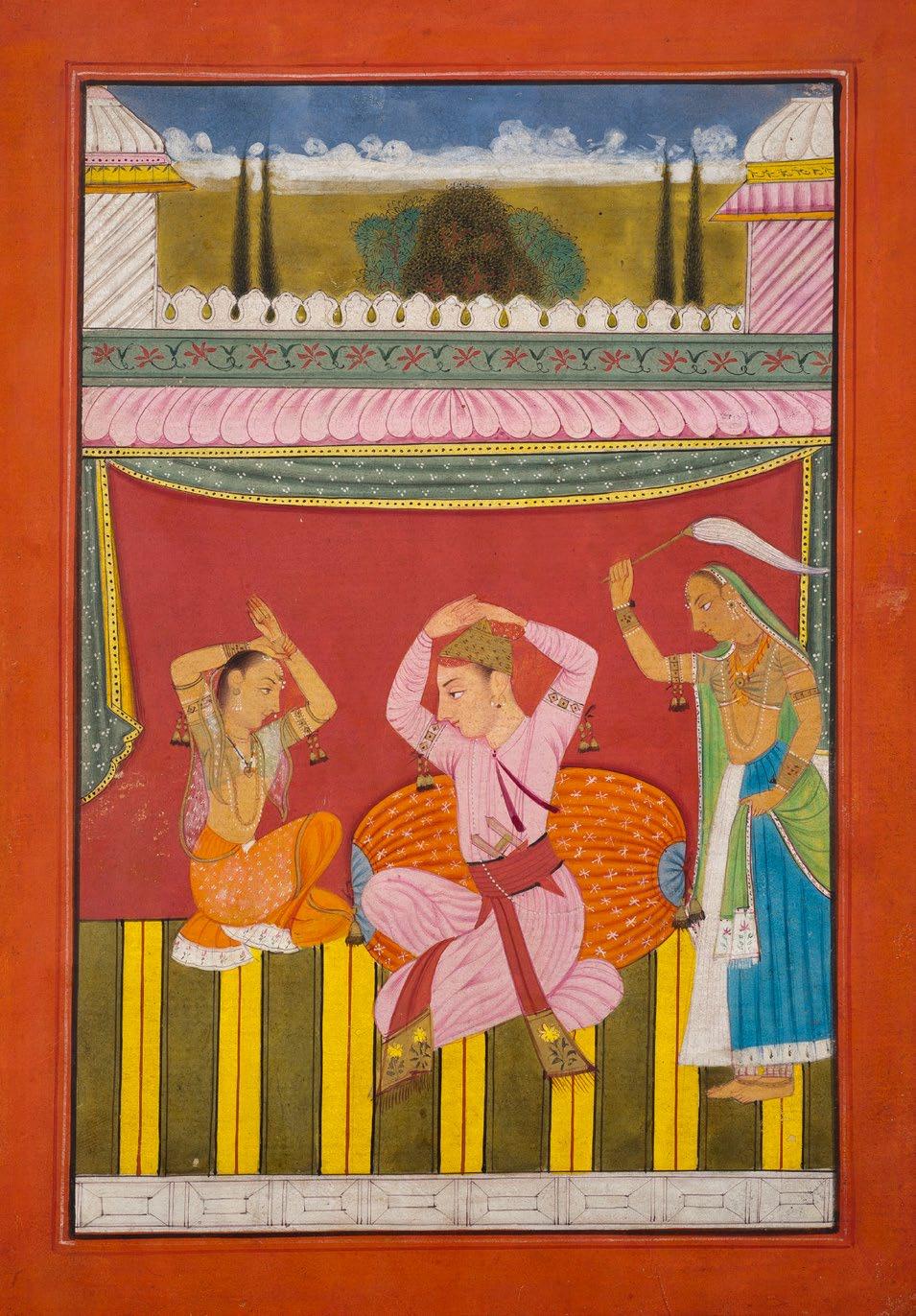
64 - ASIAN ART SOCIETY
november 2022 - 65
Vis HN u
India
Early Vijayanagar Period
14th - 15th century
Bronze
24 cm (h) x 16 cm (w) x 11 cm (depth)
price: 22.000 euros
This powerful Indian bronze is in the continuity of the Chola style in the early beginning of the Vijayanagar period. The details such as the holy cordon are modeled delicatly. Visnhu is the protector god, the curator of the cosmos. This sculpture represents Vishnu with his usual attributes. He holds the solar disk in his upper right hand, sudhdarshan chakra, symbolizing the mind. With his lower left hand, he holds the mace, gaddha, which represents the individual existence. The lotus flower, padma, is in his upper left hand, it represents the liberation. With his lower right hand, Vishnu does a sign and does not bear a conch. His head is adorned by a high crown to show his supreme authority. A holy cordon decorates his chest and bracelets representing the goal of life are attached around his wrist.
Obje C t P R e S e N ted by:
Alexis Renard
T: + 33 1 44 07 33 02
E: alexis@alexisrenard.com
W: www.alexisrenard.com
66 - ASIAN ART SOCIETY 22

november 2022 - 67
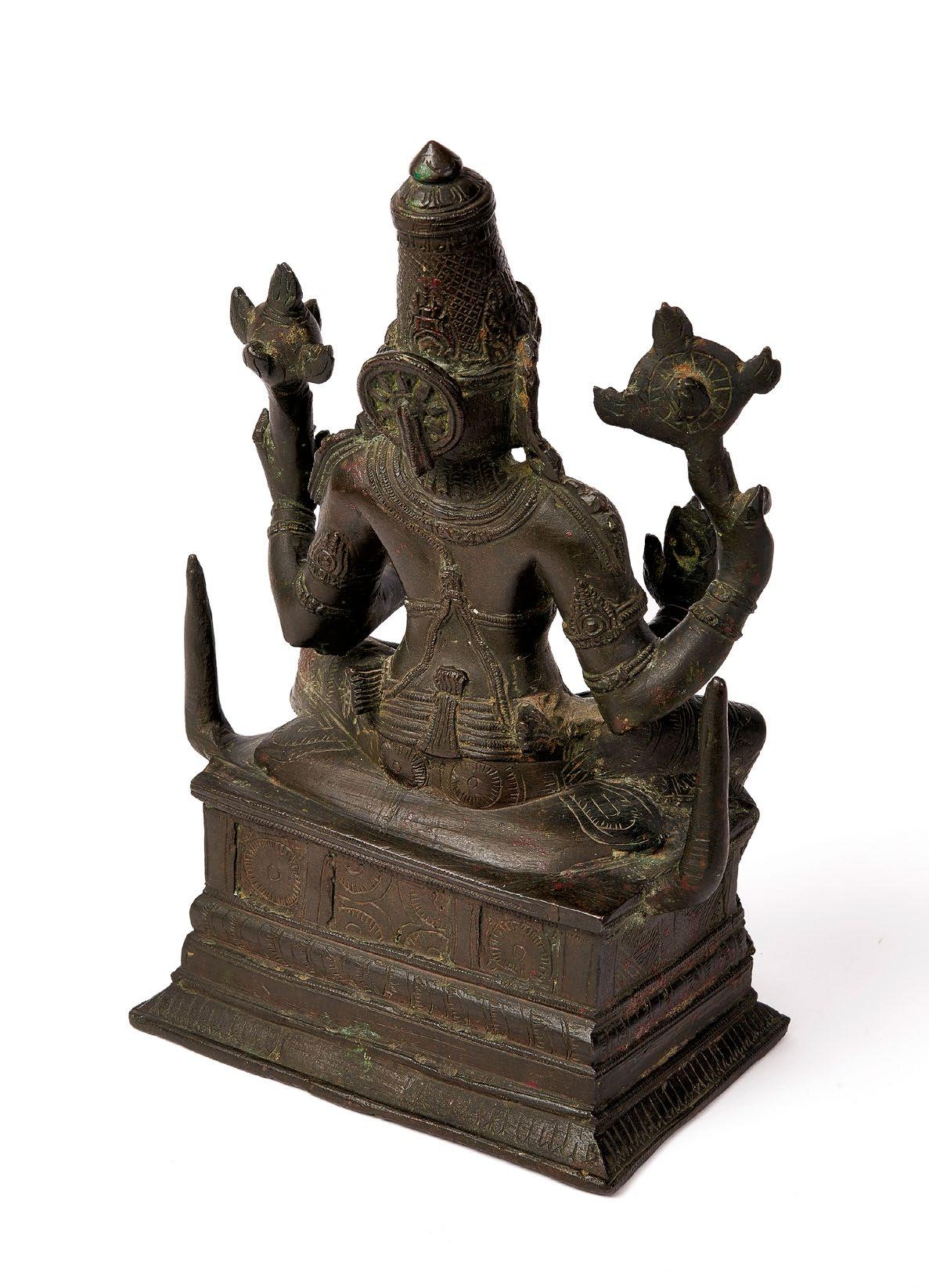
november 2022 - 69

70 - ASIAN ART SOCIETY
a TERR a COTTa fi G u RE
Gupta period
India
4-5th century
Height:29 cm
Width: 20 cm
price 14.000 USD
Obje C t P R e S e N ted by:
Sue Ollemans
M: + 44 (0) 7775 566 356
E: sue@ollemans.com
W: www.ollemans.com
november 2022 - 71 23

72 - ASIAN ART SOCIETY
sTE l E O f Ga NE s H a
China
Northern India
pala period
10th-11th century Black stone
Height: 75 cm
provenance : Jean-Claude Moreau-Gobard collection, paris, 4 November 1997 price on request
Gaṇeśa, a particularly venerated god
This fragment of decoration, carved in high relief, depicts Gaṇeśa seated in latitasana on a cushion, his right tusk broken, his narrow-eyed face framed by his large ears, his trunk dipping into a modaka bowl that he carries in one of his left hands. In his other hands he holds an axe, paraśu, which is also one of Śiva’s attributes, consistently present on his representations. He also holds the Mâlâ and other Buddhist attributes. His body is adorned with jewels and his forehead is girded with an elaborate tiara.Son of Śiva and Pārvatī, this elephant-headed god enjoys great popular fervor, and he is worshipped in the various streams of Hinduism. He is the one who removes obstacles, and contributes to the prosperity of any enterprise. As a greedy god, his devotees honor him with offerings, especially sweets, which are placed at the foot of the god’s statues.
the purity of the forms in the service of the dynamism of the composition
Under the pala dynasty, whose rulers were mostly Buddhist, religious diversity was nevertheless encouraged. pala art emerged on the model of the Gupta idiom, which had a great posterity in India, and which also spread to China, Japan and Korea. These canons are thus reused to create a full-fledged part of the Pala period. Here, the sobriety of the forms, the elegance of the movement, are particularly admirable and make this Gaṇeśa a very fine example of Pala art. To the refinement of the details and ornaments of the god are mixed energyand elegance. To the refinement of the details and ornaments of the god are mixed energy and elegance. The richness of the sculpted details To this purity of the body’s forms is added the decorative treatment of the ornaments, in particular the tiara on the god’s head, as well as the necklaces around his neck and the bracelets on his arms.
Christophe Hioco
T: +33 (0) 1 53 30 09 65
E: info@galeriehioco.com
W: www.galeriehioco.com
the richness of the sculpted details
To this purity of the body’s forms is added the decorative treatment of the ornaments, in particular the tiara on the god’s head, as well as the necklaces around his neck and the bracelets on his arms. His clothing, almost imperceptible, translates this desire of Indian artists to create luminous images, according to a religious prerequisite evoked in the texts.
november 2022 - 73 24
Obje C t P R e S e N ted by:
dE i T y H E ad
Mathurā, Uttar Pradesh, North India
5th-6th century
Sandstone
Height: 22 cm
provenance :
private French collection, 1980-1990
price: 18.000 euros
The Gupta period (4th – 6th century) is often considered the classical period of Indian art. This head of a deity of great quality is a witness of this Gupta art, the red sandstone very slightly speckled and the style link it more precisely to the Mathurā school.
The brilliant school of Mathurā
Initially a place of pilgrimage in the north of India, the Mathurā region saw the development of an artistic school from the 3rd century onwards which had a flourishing production. The Mathurā school has indeed produced numerous religious sculptures, all of which are made of red sandstone, sometimes speckled. The know-how of the sculptors ensures a great durability to this school, whose production still continues in the medieval period. This sculpture is thus an exceptional witness to the incredible artistic production of the Mathurā school of the first centuries of our era. It flourished first under the Ku āṇa rulers, then under the Gupta dynasty.
the gupta aesthetic, the classical period of indian art
Obje C t P R e S e N ted by:
Christophe Hioco
T: +33 (0) 1 53 30 09 65
E: info@galeriehioco.com
W: www.galeriehioco.com
The Gupta period is often referred to as the “golden age” of Indian art, where humanism triumphs in religious art. Here, the face with its stylized features, with its sober and soft modeling, joins this aesthetic so appreciated. The same is true for the very large, slightly protruding eyes with hemmed and incised contours, which are placed under curved eyebrows. Nevertheless, if the dating corresponds to the Gupta period, we note some resurgences of the Kusana aesthetic. Indeed, given the artistic effervescence that reigned in this region for centuries, the production bears witness to certain reminiscences, such as the full shape of the face or the strongly marked smile.
The very elaborate treatment of the hairstyle is particularly noteworthy. Two strands of hair on either side of the forehead, separated by what appears to be a medallion. The rest of the hair is held back by a beaded headband decorated with stylized floral motifs. Unfortunately, the back of the skull is missing, so the rest of the hair has not been preserved.
74 - ASIAN ART SOCIETY 25

november 2022 - 75
the popularity of human images
If the identification escapes us – is it the image of a deity? This enigmatic face nevertheless has the appearance of a mask, the meaning of which seems difficult to detect. probably part of a temple decoration, the fragmentary nature seems to confirm this hypothesis. However, this head is the perfect example of an image that effectively combines an accessible human figure with the sublime. The gentle humanity so valued in Gupta sculpture is evident in this finely carved face with slightly petulant lips and full cheeks. One must also admire the noticeably arched eyebrows and the extremely soft modeling.
76 - ASIAN ART SOCIETY
november 2022 - 77
Attributed to Manaku (Active c.1725 - c.1760)
Guler, India
Circa 1740
Gouache and gold on paper
31,7 cm x 21,6 cm
provenance:
Acquired in NY, July 7th, 1982. price on request
After Brahma rises from the navel of Vishnu, he goes on to create various gods and divine sages; then he creates Manu, the “progenitor of all men.” Manu asks Brahma to pull the earth from the ocean so that he, his wife Satarupa, and his future family will all have a place to live. Brahma then goes to invoke his own creator, Vishnu, and almost immediately a tiny boar falls from his nose.
“While he (Brahma) was looking on, a great miracle took place: the small boar in the sky shot up to the size of an elephant in a moment. Along with the Brahmanas with Marici as their chief with Kumaras and with Man, he saw the boar form and began to think in various ways. “Is it the transcendental being appearing in the form of a boar? ‘What a miracle that it should come out of my nose! It appeared like the tip of a thumb and in a moment it became as big as a great boulder. Can this be the divine sacrifice (i.e. Vishnu) himself who is trying my mind to exhaustion (by concealing his real form)?’” The master artist Manaku has brilliantly rendered against a bold yellow background, reminiscent of his earlier Gita Govinda series, this rare work illustrating the moment in which Brahma; pot of holy water and sacred text in hand- with four crowned heads and a superbly detailed grey beard, as well as Manu and his wife, look at the newly arrived boar “as big as a great boulder,” who has just revealed himself as the third incarnation of Vishnu: Varaha, the Boar Avatar.
Obje C t P R e S e N ted by:
Kapoor Galleries
M: + 1 (212) 794-2300
E: info@kapoors.com
W: www.kapoors.com
The detailing is superb; from the rosetint edged petals of the lotus flowers in Varaha’s shimmering crown, as well as the one he clasps along with the other three ayudhas (the conch, discus, and mace), the text on the sutra Brahma grasps, the sensitive handling of the fingers on each figures hand, the way the divine jewels of the celestial beings glisten on their bodies while dhotis flow with a sense of movement, to Varaha, painted in shimmering blue. Individual and deep emotion are portrayed in each figure’s eyes. Enhanced by these fine details, it is the reigning stillness in the page that moves the most. Manaku’s mastery of spatial dynamics, detail, and vivid color. Nothing else is brought into the space of this leaf as the mysterious, esoteric dialogue between the created and the creator proceeds.
78 - ASIAN ART SOCIETY 26
aT i ON
OOK T HREE O f
B H a GaVaTa
R a Na: T HE sTORy O f C RE aT i ON Va R a H a, THE B Oa R
a RNaT i ON O f Vis HN u aPPE a R s BE fORE B R a HM a, Ma N u, a N d s aTa Ru Pa
i llus TR
TO B
THE
Pu
iNC


80 - ASIAN ART SOCIETY
For other illustrations from this series see Goswamy, B. N., and Manaku. Manaku of Guler: the Life and Work of Another Great Indian Painter from a Small Hill State. Artibus Asiae publishers, 2017, pgs. 146- 167, illustrations C45- C55.

november 2022 - 81

82 - ASIAN ART SOCIETY
sH i sH i l i ON Mas K
Japan
Edo or early Meiji period
19th century
Wood, pigment traces
15,3 cm x 31 cm x 21 cm
provenance:
Sheldon Kent collection price on reques
Obje C t P R e S e N ted by:
Thomas Murray
M: + 1 415.378.0716
E: thomas@tmurrayarts.com
W : www.tmurrayarts.com
Lion masks were used in the shi shi mai festival and known to help to bring good fortune and ward off evil spirits.
This is a marvelous example of a village folk art form.
november 2022 - 83 27

84 - ASIAN ART SOCIETY

november 2022 - 85
f l OWER B as KET Na ME d "Sono" (Ga R d EN)
Tanabe Chikuunsai II (1910-2000). Signed as Chikuunsai zo (Made by Chikuunsai)and seal as Chikuunsai
Circa 1944-1955
Madake bamboo, rattan & urushi lacquer, Tomobako (original wooden storage box) & otoshi price on request

Obje C t P R e S e N ted by:
Galerie Mingei
M: +33 (0)6 09 76 60 68
E: mingei.arts.gallery@gmail.com
W: www.mingei.gallery
86 - ASIAN ART SOCIETY 28

november 2022 - 87
lOW TE a Ta B l E
Edo period
19th century
Wood, urushi lacquer, metal fitting, silk cord. Old storage
wooden box
28 cm x 28 cm x 18,5 cm (h)
price:
Obje C t P R e S e N ted by:
Galerie Mingei
M: +33 (0)6 09 76 60 68
E: mingei.arts.gallery@gmail.com
W: www.mingei.gallery
88 - ASIAN ART SOCIETY
29
SOLD
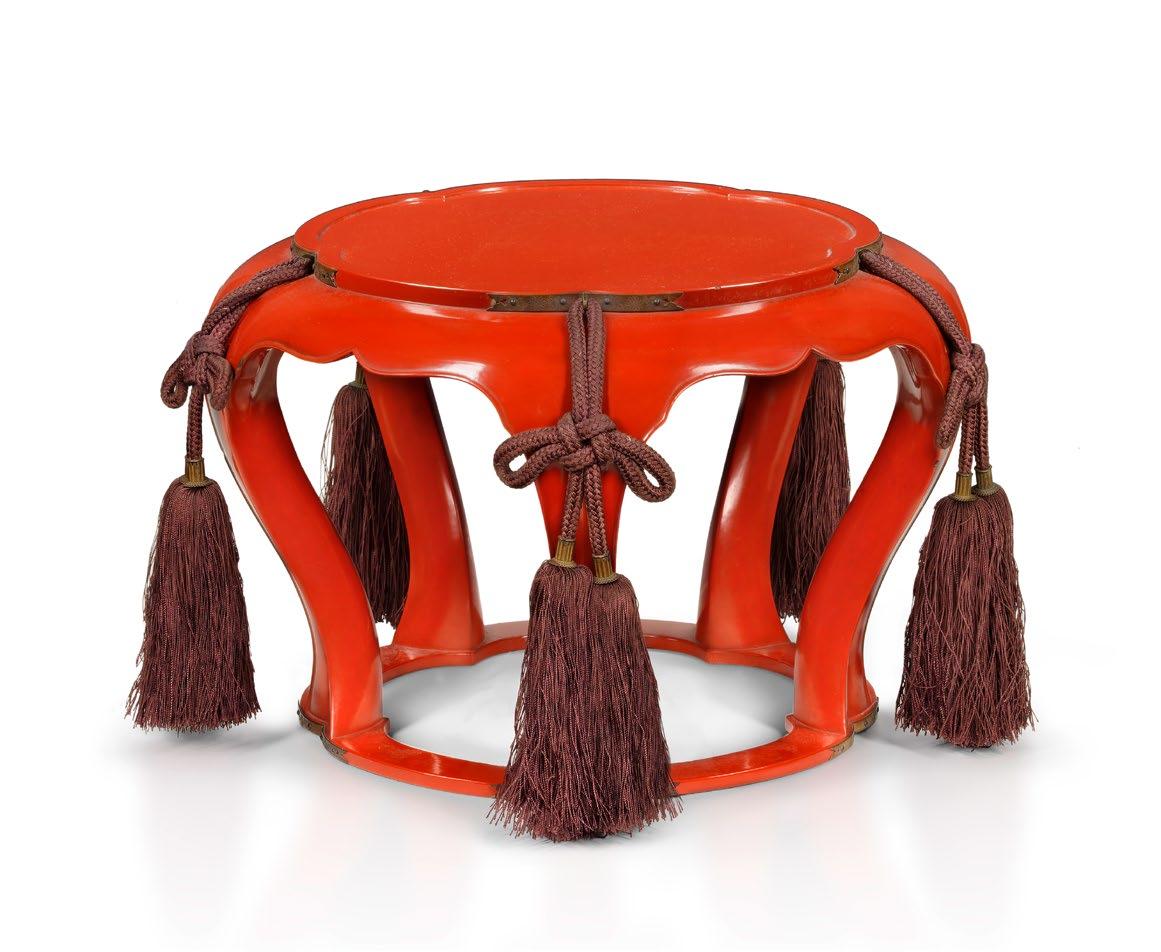
november 2022 - 89
Document box with chrysanthemum and paulownia crest design.
Ki K u K i R i Z u Ga R a
M a K i-E fu B a KO
Taishō period (1912-1926)
Wood, urushi lacquer, maki-e.
Kiribako (wooden storage box)
21,5 cm x 16 cm x 7,5 cm (h)
price: 2.600 euros
Obje C t P R e S e N ted by:
Galerie Mingei
M: +33 (0)6 09 76 60 68
E: mingei.arts.gallery@gmail.com
W: www.mingei.gallery
90 - ASIAN ART SOCIETY 30

november 2022 - 91
s a N u K i-BOR i K aTaT su M u R i MOR i MONO-BON
Signed by Seibundo and seals: Yamabuchi & Seibundo zo.
Early Showa period
Circa 1920s- 1930s
46 cm x 54 cm
Wood, urushi lacquer and pigments, Tomobako. Hakogaki: Sanuki-bori, hagata morimono bon. Seibundo zo. Sanuki lacquer carving, a leaf-shaped tray for arranging seasonal fruits and leaves, made by Seibundo
price: 2.200 euros
Leaf-shaped sencha tray with snail design.
Takamatsu City, home of the Seibundo studio, was the center of Sanuki-style lacquer production based in Kagawa prefecture on the Island of Shikoku. The city spawned the Living National Treasure Otomaru Kodo among many other influential lacquer and carving artists.
Obje C t P R e S e N ted by:
Galerie Mingei
M: +33 (0)6 09 76 60 68
E: mingei.arts.gallery@gmail.com
W: www.mingei.gallery
92 - ASIAN ART SOCIETY 31

november 2022 - 93

Jizō in a zu S hi (PORTa B l E s HR i NE)
Japan 17th century Edo period
Gold, lacquer and colour on wood
19 cm (h) x 11 cm (w) x 8,5 cm (D.) (Zushi), 10 cm (h) x 6 cm (w) x 4,5 cm (D.) (Figure)
price: 9.800 euros
Obje C t P R e S e N ted by:
Gregg Baker Asian Art
M: +44 (0) 20 7221 3533
E: info@japanesescreens.com
W: www.japanesescreens.com
A lacquered wood zushi (travelling shrine), containing a figure of Jizō Bosatsu seated in hanka-fumisage (the half-lotus position with one leg folded and the other pendant) on a rocky base before a halo with three Nyoihōju (wish granting jewels). Jizō is bejewelled with a giltmetal yōraku (pectoral ornament) with semi-precious stone beads and holds a shakujō (priest staff) in the right hand and a Nyoi-hōju in the left. The robes are decorated with floral foliage and geometric designs in kirikane (thinly cut gold patterns). The black-lacquered shrine has gilt metal mounts and the interior is gilded.
Jizō Bosatsu is one of the most beloved Japanese divinities and a bodhisattva who is believed to save all beings during the era between the death of Shaka (Gautama Buddha) and the rise of Miroku Bosatsu (Maitreya, a future Buddha). Jizō’s Sanskrit name Kshitigarbha means “the earth” and “containment” or “womb”. As such Jizō is considered to personify the “virtue of the earth”. He vowed not to achieve Buddhahood until all are saved, and thus is represented as a simple monk and embodies compassion and universal salvation. Jizō guards travellers safely on their way, protects warriors in battle, watches over the safety of children, families and women during pregnancy. As a guardian of children, he is often depicted in an endearing manner to resemble the children he protects. The Jizō in the hanka-fumisage position such as the present figure is particularly considered to represent Enmei Jizō (Life-Prolonging Jizō) and people revered them for easy childbirth and longevity.
Jizo is usually shown in the guise of a priest carrying a nyoi-hōju (a jewel which grants desires) and a shakujō (priest staff). Nyoi-hōju means a jewel that has the capacity to grant fulfilment of all desires. In Buddhism, by its luminosity and brilliance, it symbolises the Buddha and the Doctrine. As a pearl, an emblem of purity, it also represents the truth of the Buddha and the veracity of the Law.
This present figure is decorated with kirikane (thinly cut gold patterns) on a plain wood, intended to evoke the
november 2022 - 95 32
appearance of sandalwood sculpture. One of the wellknown Buddhist figures decorated in a similar way is a seated Yakushi Nyorai (date 1103, H. 10.7cm, National Treasure), a hibutsu (hidden Buddha or secret Buddha) of Ninnaji temple, Kyoto.
For more details, please visit: http://japanesescreens.com

96 - ASIAN ART SOCIETY


november 2022 - 97
sENGai Gi BON (1750-1837)
The Lucky God Jurōjin Riding a Deer
Japan, first half 19th century Ink on paper
H. 165,0 (88,0) x D. 31,0 (27,5) cm price on request
painting inscribed and signed by the artist. Comes with new, fitted wooden box, in which the old original lid with a collector’s inscription from 1946 is inserted.
A painting by Zen master painter Sengai Gibon (17501837) with a depiction of one of the Seven Lucky Gods (shichi fukujin) called Jurōjin. Jurōjin is a figure being venerated in China and Japan as a symbol for wisdom, eruditeness, and long life. Usually depicted as dignified old men, draped by long, noble robes, standing in a calm position, he is here painted in Sengais fluent brushstroke in highly unusual manner as a happy, lively old man, enjoying himself by riding around on his fellow animal, a deer.
Sengai is one of the most famous Zen masters of Japan and next to Hakuin one of the best Zen painters in history. He was born as son of a tenant farmer, who was given to a local temple Seitai-ji at the age of eleven. There he received the tonsure and his monk’s name Gibon. He studied under Gessen Zenne (1702-1781) at Tōki-an in-today’s Yokohama and spend some years after the death of his master in 1781 possibly wandering around the country, before he settled on Kyūshū at the age of 39. He became abbot of Shōkoku-ji in Hakata, Fukuoka, which was build 1195 by Myōan Eisai (11411215) as first official Zen temple in Japan, but run-down at the time Sengai arrived there.
Obje C t P R e S e N ted by:
Galerie Kommoss
M: +49 177 6033 201
E: info@galeriekommoss.com
W: www.galeriekommoss.com
Sengai did not only rebuild the temple compound but managed to restore the old location as on the flourishing centers of Zen Buddhism in Edo Japan. Due to his compassion and understanding for the common people and their simple life as well as his large portion of humor, he captured the heart of the local community. Sengai also gained large recognition within the Zen circle, which peaked in the official grant of the purple robe by the Rinzai main temple Myōshin-ji by decree of emperor Kōkaku (1771-1840), which Sengai refuses. Later, Sengai wrote in a poem: "Worldly fame and saintly titles/ Every one of them is a vain voice" (Furuta 1985, 19).
98 - ASIAN ART SOCIETY
33
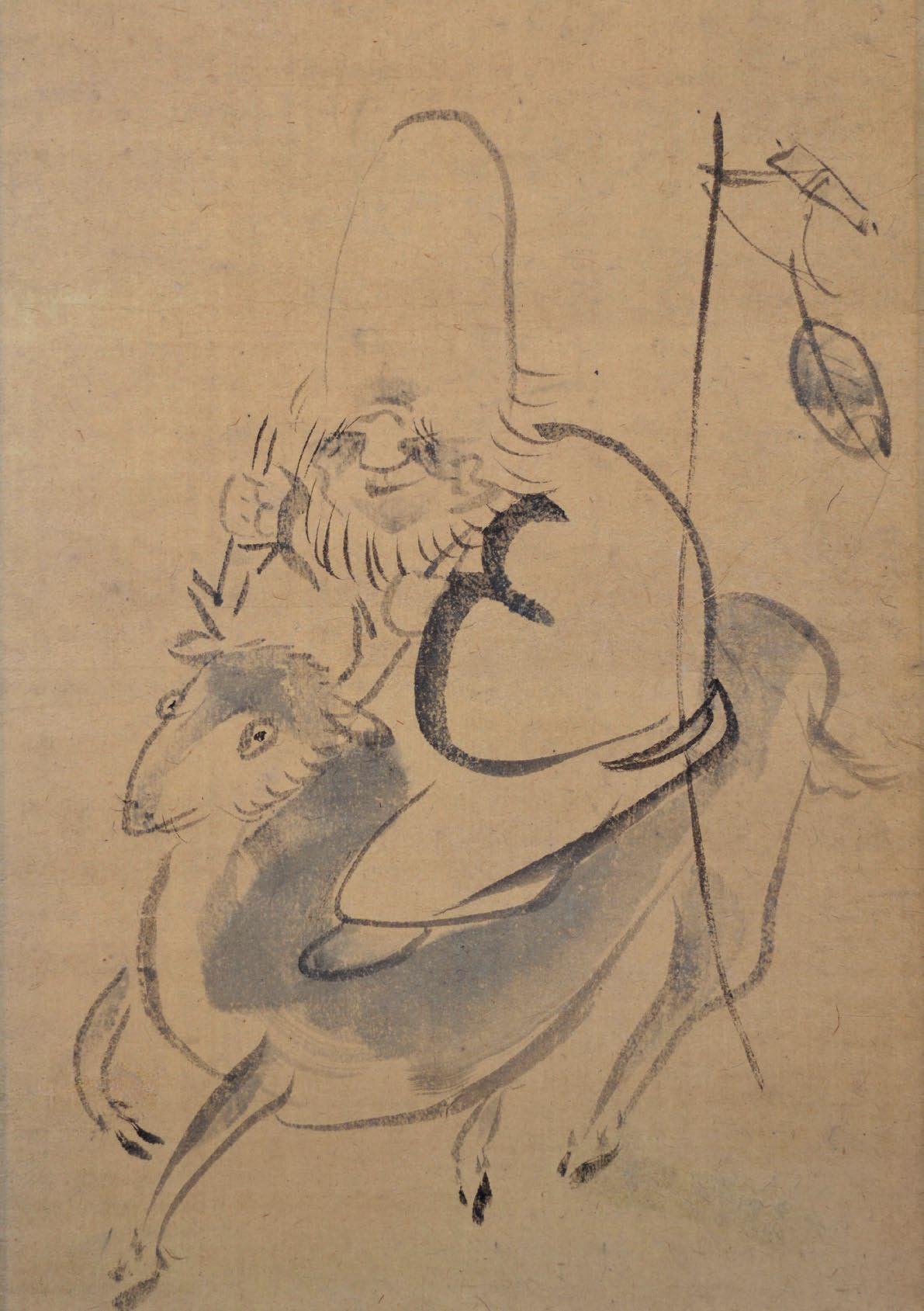
During his later lifetime, Sengai spend more and more time to create his lighthearted ink paintings for which he was well known for. His paintings and calligraphies are always humorous and look like comic-like sketches, however, they always have deeper implications drawn from his tremendous inner Zen experience. For instance, he did not shy away from using symbols of the folkloric beliefs, like in this painting. However, instead of aiming to generate a simple veneration by the viewer, he painted the lucky god as a good example, not to rely in believing to someone’s mercy, but to work on our own inner determination.
Collections (selection):
Metropolitan Museum, Fukuoka Art Museum, National Gallery of Australia, Tokyo National Museum, Idemitsu Museum of Art.
References (selection):
Suzuki, Daisetz T.: Sengai. The Zen Master, Greenwich 1971.
Furuta, Shōkin: Sengai. Master Zen Painter, transl. by Tsukimura Reiko, Tokyo/New York/London 2000.
Yuji Yamashita, Zenga – The Return from America: Zenga from the Gitter-Yelen Collection, Asano Laboratories, Inc., 2000, pp. 117–124.

100 - ASIAN ART SOCIETY
november 2022 - 101
K O-sH i Ga R a K i fRE s H WaTER ja R (mizu S a S hi)
Japan, Edo period, early 17th Century
Ash glazed stone ware, lacquered lid
H 14,0 x W 16,5 x D 16,0 cm Inv. No. #20.019
Comes with fitted wooden box, inscribed, and certified by Shigaraki potter Ueda Naokata V (1927–2015)
price: 12.000 euros
Bold freshwater jar of square shape and rustic impression with certification by Ueda Noakata V. Made of dark Shigaraki clay, it has a rough texture with many cracks and impurities in it. The body is partly covered by a greenish, milky natural ash glaze. The jar was possibly thrown on a potter’s wheel and then trimmed and shaped with a paddle to a square form. The custommade lid is made of black-lacquered wood and fits perfectly on the vessel’s mouth.
The fitted storage box, inscribed by Naokata, certifies: Ko-shigaraki shihō mizusashi ("Old Shigaraki Square Fresh Water Jar"), Shikaraku-gama ("purple-scent pleasure kiln"), Naokata shiki ("identified by Naokata"). Ueda Naokata V was born in Shigaraki and completed his studies at the Kyōto National Ceramics Laboratory. He trained under his father Ueda Naokata IV (1898-1975) whom he succeeded in the year of his death in 1975. Ueda V was selected for the Asahi Ceramic Art Exhibition and the Japan Traditional Art Crafts Exhibition. He had many exhibitions at the Takashimaya department store in Kyōto and many other locations and was a member of the reputable Japan Crafts Association (Nihon Kōgeikai).
Obje C t P R e S e N ted by:
Galerie Kommoss
M: +49 177 6033 201
E: info@galeriekommoss.com
W: www.galeriekommoss.com
102 - ASIAN ART SOCIETY 34

november 2022 - 103

Guri Guri
M E di C i NE CONTai NER
Batak, Sumatra
19th century
Wood, Chinese trade porcelain
Height: 17 cm
provenance:
Old Japanese collection
price: 8.000 USD
The clan progenitor holds a child, possibly representing future generations, or perhaps something darker related to the origins of puk-puk, the magic substance contained therein.
Obje C t P R e S e N ted by:
Thomas Murray
M: + 1 415.378.0716
E: thomas@tmurrayarts.com
W: www.tmurrayarts.com
november 2022 - 105
35

106 - ASIAN ART SOCIETY

november 2022 - 107
a G O ld a N d
iNTa N d ia MON d
B R a CE l ET i N
THE fORM O f a
s ERPENT
Yogyakarta, Indonesia
19th century
Diamond
Diam.: 6 cm
price: 4.000 USD
Obje C t P R e S e N ted by:
Sue Ollemans
M: + 44 (0) 7775 566 356
E: sue@ollemans.com
W: www.ollemans.com
108 - ASIAN ART SOCIETY
36

november 2022 - 109
110 - ASIAN ART SOCIETY

